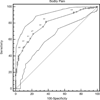Clinically important changes in short form 36 health survey scales for use in rheumatoid arthritis clinical trials: the impact of low responsiveness
- PMID: 24980417
- PMCID: PMC4245332
- DOI: 10.1002/acr.22392
Clinically important changes in short form 36 health survey scales for use in rheumatoid arthritis clinical trials: the impact of low responsiveness
Abstract
Objective: Despite wide use of the Short-Form 36 (SF-36) health survey in clinical trials of rheumatoid arthritis (RA), estimates of minimum clinically important improvement (MCII) for its scales are not well-established. We estimated MCIIs for SF-36 scales in patients with active RA.
Methods: In this prospective longitudinal study, we studied 243 patients who had active RA and who completed the SF-36 before and after treatment escalation. We first assessed responsiveness with standardized response means (SRMs). For scales with adequate responsiveness (SRM ≥0.50), we used patient judgments of improvement in arthritis status as anchors for estimating MCIIs. We used receiver operating characteristic curve analysis to identify the MCIIs as the change associated with a specificity of 0.80 for improvement.
Results: Patients had substantial improvement in RA activity with treatment. However, among SF-36 scales, only the physical functioning and bodily pain scales and the physical component summary had adequate responsiveness. Using 0.80 specificity for improvement as the criterion, the MCIIs were 7.1 for the physical functioning scale, 4.9 for the bodily pain scale, and 7.2 for the physical component summary.
Conclusion: Low responsiveness precluded estimation of valid MCIIs for many SF-36 scales in patients with RA, particularly the scales assessing mental health. Although the SF-36 has been included in many clinical trials to broaden the assessment of health status, low responsiveness limits the interpretation of changes in its mental health-related scales.
Published 2014. This article is a U.S. Government work and is in the public domain in the USA.
Conflict of interest statement
None of the authors has any commercial or financial interests or conflicts related to this work.
Figures



References
-
- U.S. Centers for Disease Control and Prevention. [accessed on October 2, 2013];Healthy People 2020. www.cdc.gov/nchs/healthy_people/hp2020.htm.
-
- Wilson IB, Cleary PD. Linking clinical variables with health-related quality of life: A conceptual model of patient outcomes. JAMA. 1995;273:59–65. - PubMed
-
- Fries JF, Spitz P, Kraines RG, Holman HR. Measurement of patient outcome in arthritis. Arthritis Rheum. 1980;23:137–145. - PubMed
-
- Tugwell P, Wells G, Strand V, Maetzel A, Bombardier C, Crawford B, et al. Clinical improvement as reflected in measures of function and health-related quality of life following treatment with leflunomide compared with methotrexate in patients with rheumatoid arthritis. Arthritis Rheum. 2000;43:506–514. - PubMed
-
- Genovese MC, Schiff M, Luggen M, Becker J-C, Aranda R, Teng J, et al. Efficacy and safety of the selective co-stimulation modulator abatacept following 2 years of treatment in patients with rheumatoid arthritis and an inadequate response to anti-tumour necrosis factor therapy. Ann Rheum Dis. 2008;67:547–554. - PubMed
Publication types
MeSH terms
Substances
Grants and funding
LinkOut - more resources
Full Text Sources
Other Literature Sources
Medical

